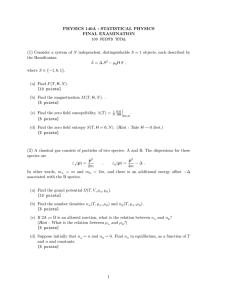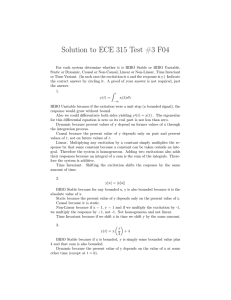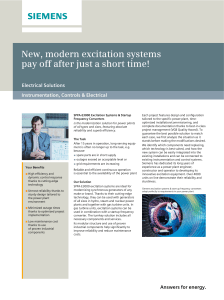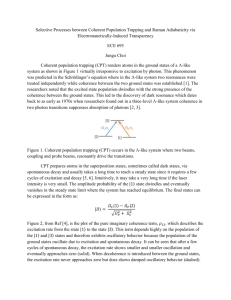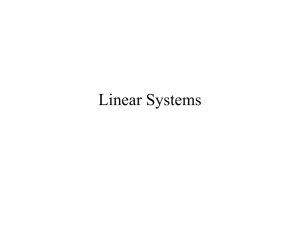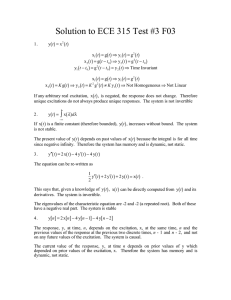Solution to ECE Test #2 Su05
advertisement
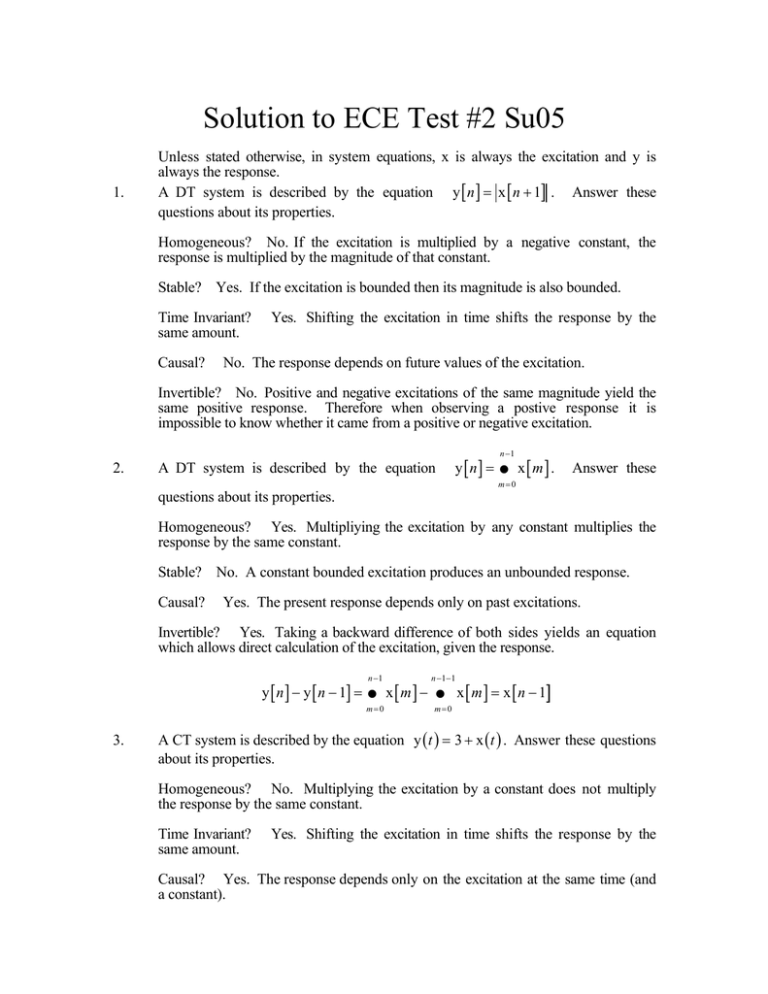
Solution to ECE Test #2 Su05 1. Unless stated otherwise, in system equations, x is always the excitation and y is always the response. A DT system is described by the equation y [ n ] = x [ n + 1] . Answer these questions about its properties. Homogeneous? No. If the excitation is multiplied by a negative constant, the response is multiplied by the magnitude of that constant. Stable? Yes. If the excitation is bounded then its magnitude is also bounded. Time Invariant? same amount. Causal? Yes. Shifting the excitation in time shifts the response by the No. The response depends on future values of the excitation. Invertible? No. Positive and negative excitations of the same magnitude yield the same positive response. Therefore when observing a postive response it is impossible to know whether it came from a positive or negative excitation. 2. A DT system is described by the equation y[n] = n −1 ∑ x[m] . Answer these m=0 questions about its properties. Homogeneous? Yes. Multipliying the excitation by any constant multiplies the response by the same constant. Stable? No. A constant bounded excitation produces an unbounded response. Causal? Yes. The present response depends only on past excitations. Invertible? Yes. Taking a backward difference of both sides yields an equation which allows direct calculation of the excitation, given the response. y [ n ] − y [ n − 1] = 3. n −1 n − 1− 1 m=0 m=0 ∑ x [ m ] − ∑ x [ m ] = x [ n − 1] A CT system is described by the equation y ( t ) = 3 + x ( t ) . Answer these questions about its properties. Homogeneous? No. Multiplying the excitation by a constant does not multiply the response by the same constant. Time Invariant? same amount. Yes. Shifting the excitation in time shifts the response by the Causal? Yes. The response depends only on the excitation at the same time (and a constant). Invertible? Yes. x ( t ) = y ( t ) − 3 . 4. A CT system is described by the equation y (t ) = t +2 ∫ x (τ ) dτ . Answer these −∞ questions about its properties. Homogeneous? Yes. Multiplication of the excitation by any constant multiplies the response by the same constant. Stable? No. A constant bounded excitation produces an unbounded response. Causal? No. The response at time t depends on the excitation at times greater than t, up to t + 2. 5. A CT system is described by the equation y ( t ) = t x ( t ) . Answer these questions about its properties. Homogeneous? Yes. Multiplication of the excitation by any constant multiplies the response by the same constant. Stable? No. A constant bounded excitation produces an unbounded response because the excitation is multiplied by t and t is unbounded. Time Invariant? response The response to x1 ( t ) = g ( t ) is No. x2 (t ) = g (t − t0 ) to y2 (t ) = t g (t − t0 ) is y1 ( t − t 0 ) = ( t − t 0 ) g ( t − t 0 ) ≠ y 2 ( t ) . 6. y1 ( t ) = t g ( t ) . If x [ n ] = ( 0.8 ) u [ n ] ∗ u [ n ] , what is the numerical value of x [ 3] ? n x[n] = x [ 3] = ∞ n m = −∞ m=0 m m ∑ ( 0.8 ) u [ m ] ∗ u [ n − m ] = ∑ ( 0.8 ) 3 ∑ ( 0.8 ) m m=0 = ( 0.8 ) + ( 0.8 ) + ( 0.8 ) + ( 0.8 ) = 2.952 0 1 2 3 , r =1 1 N or, alternately, using ∑ r = 1 − r n=0 1− r , r ≠ 1 N −1 n 1 − ( 0.8 ) x[n] = 1 − 0.8 n +1 7. 4 n +1 = 5 1 − ( 0.8 ) ⇒ x [ n ] = 5 1 − ( 0.8 ) = 2.952 If x ( t ) = 5 tri ( t / 4 ) ∗ −2δ ( t + 3) , what is the numerical value of x ( −5 ) ? The and Using x ( t ) ∗ Aδ ( t − t 0 ) = A x ( t − t 0 ) , x ( t ) = −10 tri (( t + 3) / 4 ) ⇒ x ( −5 ) = −10 tri (( −5 + 3) / 4 ) x ( −5 ) = −10 tri ( −1 / 2 ) = −5 8. Find the impulse response h ( t ) of the CT system described by y′ ( t ) + β y ( t ) = x ( t ) . For what values of β is this system stable? eλt . Characteristic equation is λ + β = 0 ⇒ λ = − β . Homogeneous solution is y h ( t ) = K h e− β t . Since y is differented more than x, the Solution form is impulse response cannot contain an impulse. Integrating from 0 − to 0 + , 0+ ( ) − h ( 0 ) + β ∫ h (t ) dt = u ( 0 ) − u ( 0 ) h 0 + − + − 0− Kh − 0 + 0 = 1 − 0 ⇒ Kh = 1 Therefore h ( t ) = e− β t u ( t ) . For stability this impulse response must be absolutely integrable. ∞ ∫ −∞ e − βt ∞ u ( t ) dt = ∫ e− β t dt = 0 1 if β > 0 . If β ≤ 0 the integral does not coverge and β the system is unstable. 9. For each impulse response indicate whether the LTI system it describes is stable or unstable. (a) h[n] = u[n] (b) h [ n ] = sin ( 2π n / 6 ) u [ n ] (c) h ( t ) = ramp ( t ) (d) h ( t ) = comb ( t ) e− t /10 u ( t ) ∞ ∫ comb ( t ) e− t /10 u ( t ) dt = −∞ ∞ ∫ −∞ (e) Unstable. Not absolutely summable. comb ( t ) e − t /10 Unstable. Not absolutely summable. Unstable. Not absolutely integrable. ∞ ∫ Stable. ∞ ∑ δ (t − k )e− t /10 dt = 0 k = −∞ ∞ u ( t ) dt = ∑ e k=0 − k /10 ∞ ∞ ∞ ∑ ∫ δ (t − k ) e − t /10 dt k = −∞ 0 ∞ 1 1 k = ∑ 1/10 = ∑ ( 0.9048 ) = = 10.5083 1 − 0.9048 k=0 e k=0 k h ( t ) = comb ( t ) − comb ( t − 1 / 2 ) u ( t ) Unstable. Integral of absolute value is the sum of the strengths of infinitely many unit impulses.
![Solution to Test #4 ECE 315 F02 [ ] [ ]](http://s2.studylib.net/store/data/011925609_1-1dc8aec0de0e59a19c055b4c6e74580e-300x300.png)

